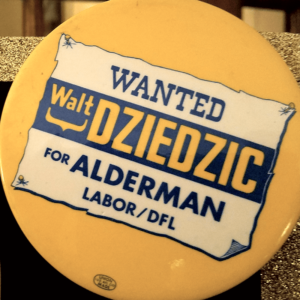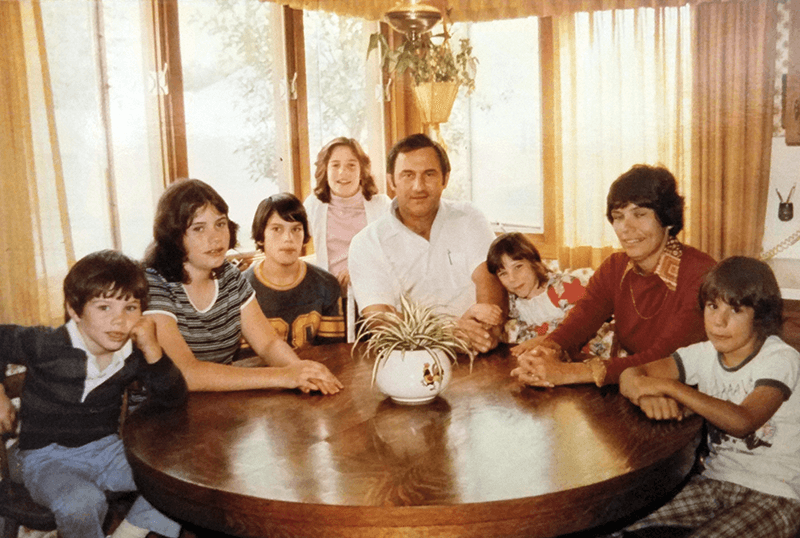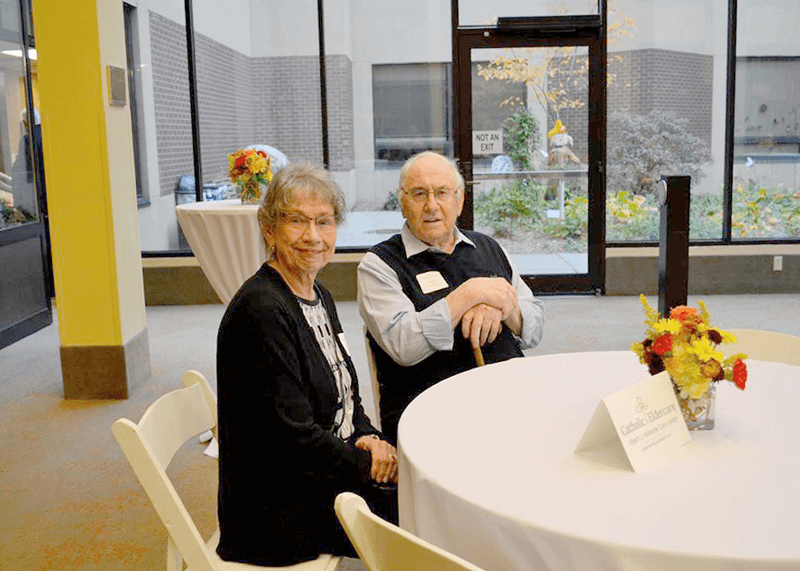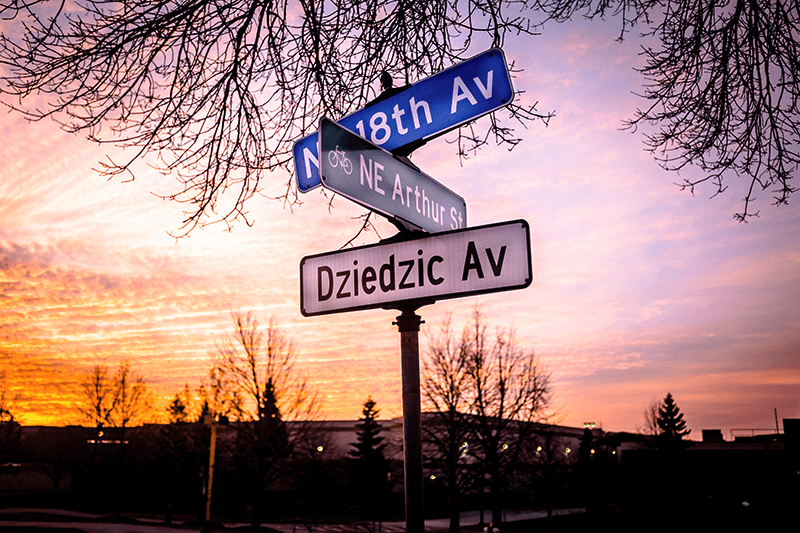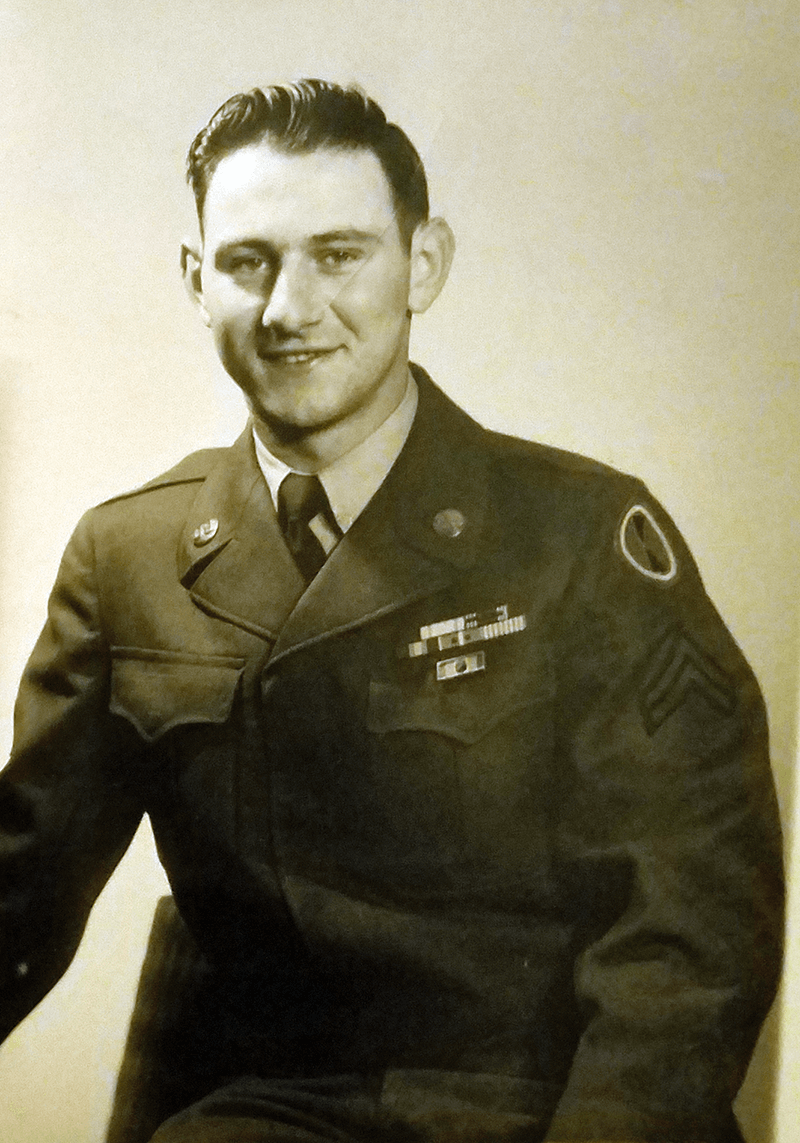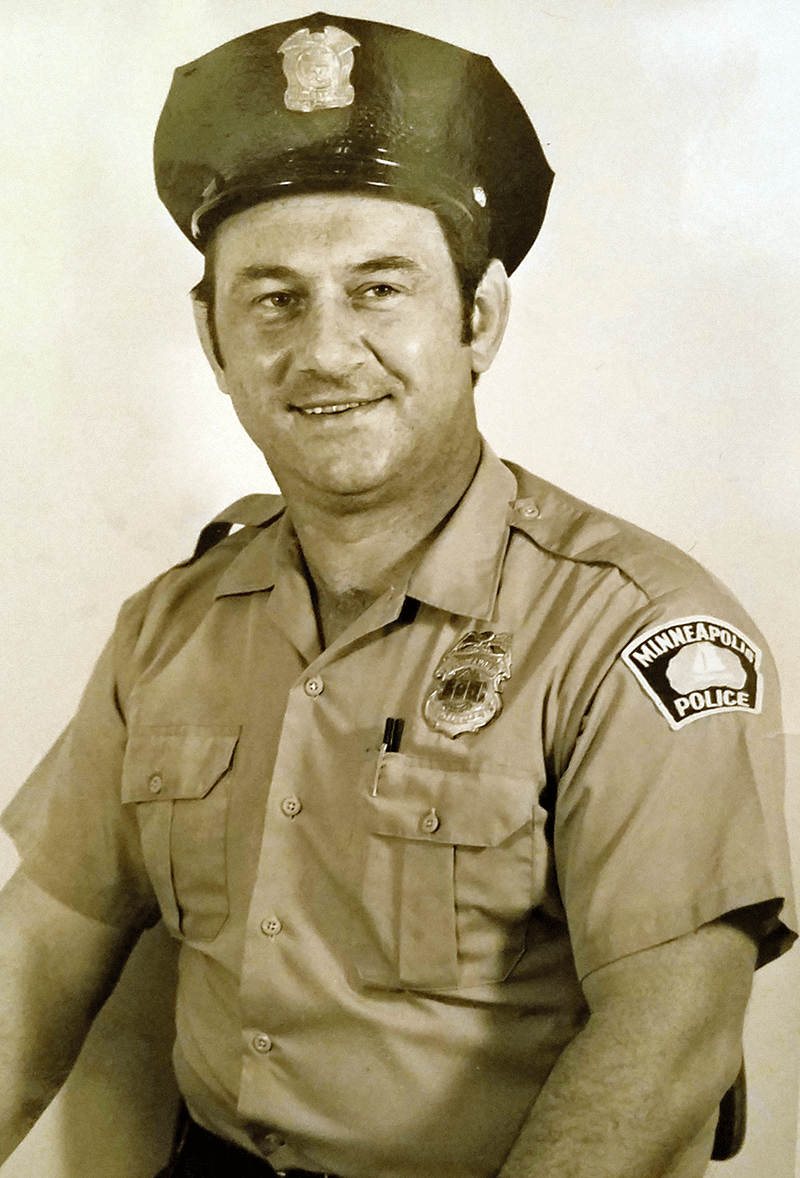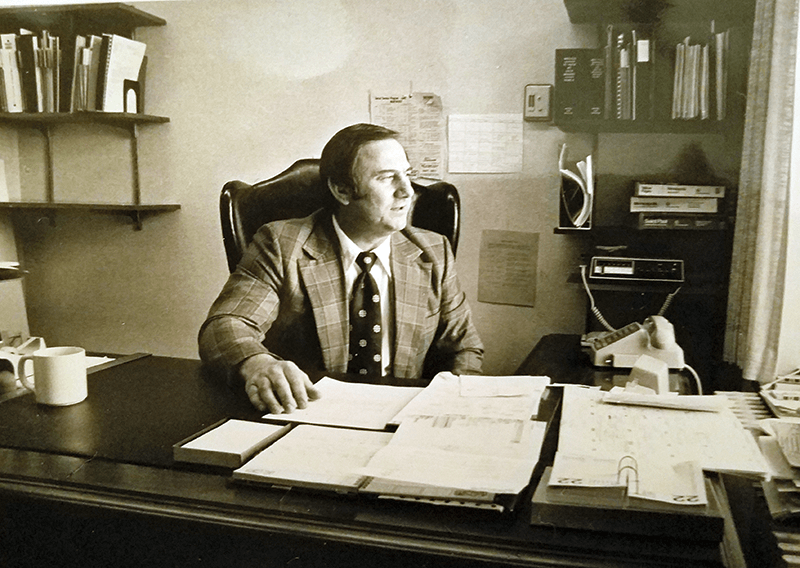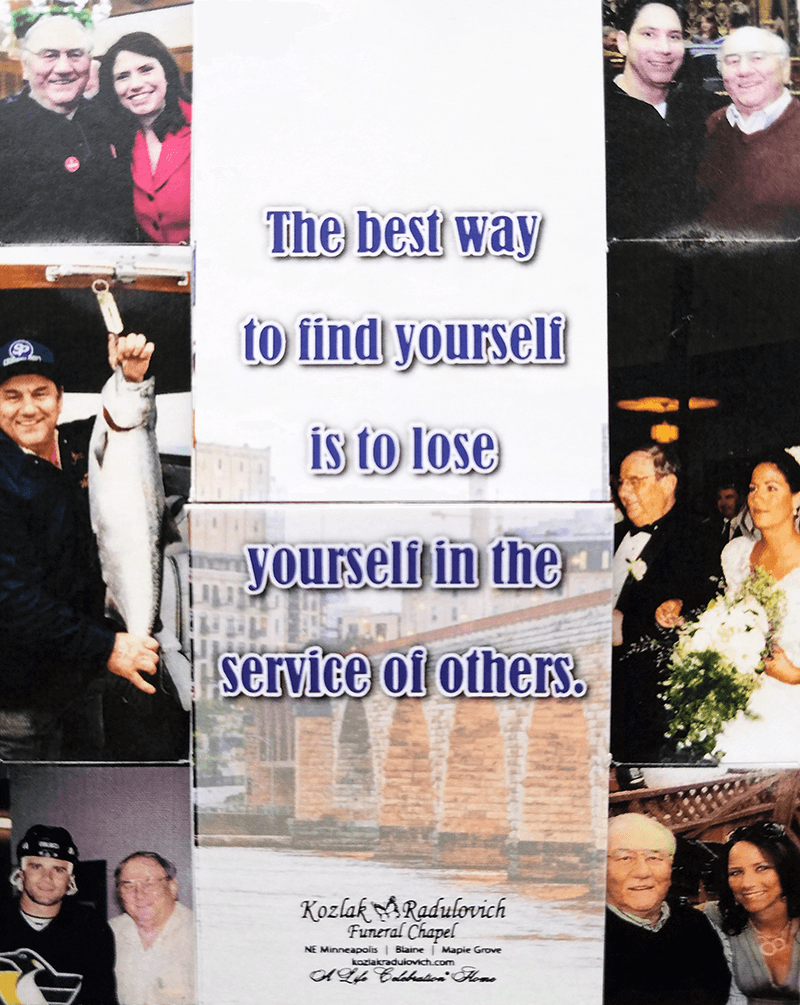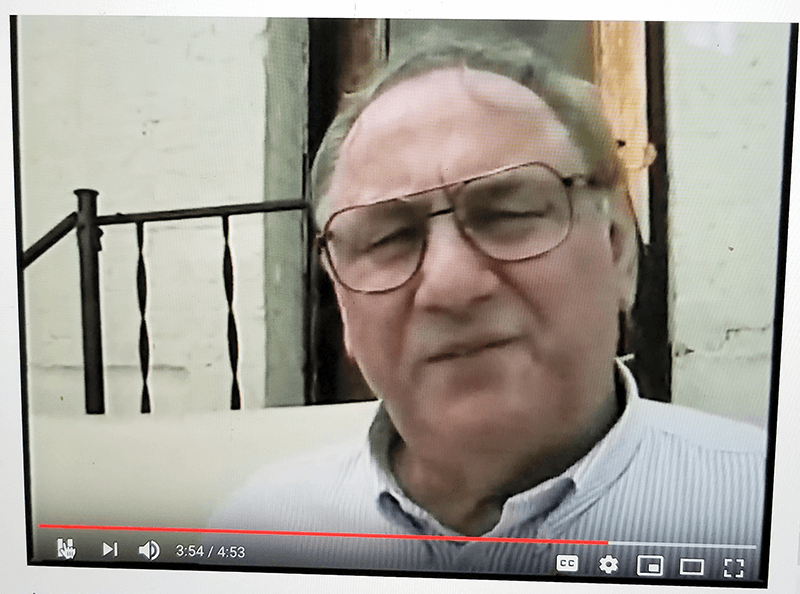He gave a “Round Tuit” award to a company that was dragging its feet on waste cleanup. He called 1982 school boundary changes for desegregation “a jigsaw puzzle” and railed at Cub Foods and other grocery chains for not building in the inner city.
Walt Dziedzic spoke his mind and fiercely stood up for what he thought would benefit his constituents, collectively and individually. Retired from elected office in 2009, Walter Paul Dziedzic died of natural causes the Saturday after Thanksgiving, and was buried on the day he would have turned 86, November 29, 2018.
Best known as the Minneapolis First Ward Alderman (that was what they called city council members then), Dziedzic was elected in a special election in 1977 when Sam Sivanich became a Hennepin County Commissioner. He’d already had careers in the military, graduated from St. Thomas, taught at De La Salle and then served as a police officer.
In 1997 at age 65, Dziedzic ran instead to represent Northeast on the Minneapolis Park and Recreation Board, a part-time commitment that he embraced as “a gear down.” He ousted a long-time incumbent and held the post for 12 years that included the controversial hiring, at his suggestion, of Jon Gurban, superintendent from 2004-2010.
Dziedzic’s job in retirement was “Papa” to a bevy of grandchildren, Aly, Andrea, Alex, Sophia, Jack, Liam, Nora, Brielle, Vienna and Hubert. Surviving family include his sister Gen Dziedzic and his wife of 57 years, Pat; adult children Kari Dziedzic, Steve (Ann Settgast) Dziedzic, Anne (Scott) Kelling, Tim (Sara) Dziedzic, Kelly (Paul) Arntzen and Joe (Kelly) Dziedzic and many in-laws.
Dziedzic was the son of Polish immigrants whose father died when Walt was age 2. The family received help from the Northeast Neighborhood House (now East Side Neighborhood Services). He supported their efforts, and from that base, took senior citizens out to a ball game annually for a “Day at the Dome.”
Early issues
In a March 1997 interview, Dziedzic talked about roots of his constituent service standard. When first hired on to the police force, he’d been told to bring in his military discharge papers so he could claim veteran’s preference, but was given a runaround. He went to see Frank Adams, the city’s veterans service officer.
“He dropped everything,” Dziedzic said, and took him back to straighten out the problem. “I learned a big lesson that day. I said that’s the way I want to be.”
Dziedzic often consulted the public by holding meetings. One such was the vote by the Northeast Park neighborhood to secede from what was then the Beltrami Project Area Committee. Another, in early 1982, about a city plan to convert many four-way stop intersections into two-ways, to allow traffic to circulate better.
He and constituents went to neighboring St. Anthony to weigh in on an all-night billiard hall that eventually went into part of St. Anthony Shopping Center, saying “I can tell you, it’s not people who are employed every day” who will frequent the place.
The city in October 1982 proposed sites for dealing with hazardous waste from elsewhere. The alderman advocated to have the Northeast sites eliminated, partly because one was near the city’s water intake, and because the area had already had its share of industrial pollution. “I wheeze,” Dziedzic said, “and I think it’s because I breathed in all that sulfur dioxide” from the coal-burning power plant growing up at 2727 Randolph.
The same arguments were made in a long fight about locating the garbage burner. When a west riverbank location was finally dead in 1984 he said, “For five years I’ve been saying we should look at something else.” In the May 8, 1985 Northeaster, he called a proposal for refuse-derived fuel burning at the Riverside plant, “just idiotic.”
Dziedzic promoted business progress, and earned appearances in many ceremonial groundbreaking photos: Swinging a sledgehammer for the remodel of the Second Precinct police station, townhomes at 23rd and Quincy, the Kenzington condo project in St. Anthony, and ribbon cutting for the Central Avenue streetscape in June 1984. He initiated planning for the armory and postal garage on Broadway in December 1984.
The numbers bore out his claim that Northeast received more than its fair share of development during his tenure. We remember a city map of development, and Northeast dotted with more spots than other areas of the city.
In mid-1983, long before the city decided to redistribute downtown tax revenue to the neighborhoods through the Neighborhood Revitalization Program, Dziedzic was seeking more money for citizen participation after the planning district citizen advisory council system ended.
That same year, Dziedzic, Congressman Martin Sabo and Minneapolis Community Development Agency executive director Jim Heltzer went to Washington to get a federal waiver that would allow new housing to be built on land that had been cleared for a freeway but stopped by neighborhood protest. “I got my idea from reading the Northeaster,” an article that revealed the federal government had been inconsistent in requiring to be paid full market value in such situations. The feds turned over the land, and the townhomes along Third Avenue proceeded.
By 1985 in a pre-primary interview, he was touting efforts to bring a supermarket to Central Avenue and to “make the backs as attractive as the fronts” to encourage shoppers to park behind stores.
In 1989’s election, candidates agreed that citywide and nationwide, drugs had eclipsed taxes as the big issue. Dziedzic said, “Drugs put us in World War Three, and we don’t even know it.”
The last four years on council
When Cub decided not to build at 18th and Central in January 1993, Dziedzic wrote them a nasty letter, said grocery stores were not building in the cities and likened it to “redlining.” Cub said there was not enough land available to support operations. At neighborhood meetings, Dziedzic cited grocery prices in the city as 18 to 26 percent higher than in the suburbs.
Reported in the August 11, 1993 Northeaster, Target and Rainbow greenlit what became The Quarry, Dziedzic’s signature achievement. The same year, the city bought the Hollywood Theater, and Dziedzic pushed to buy the lot across the street for parking.
Running for re-election, Dziedzic reflected that the city was getting more and more into social services, and “that’s the county’s job.” He won in 1993, with record turnout and with many new people working on his campaign, but his opponent mobilized many as well; the margin was 54.7 to Paul Ostrow’s 45.1 percent.
In 1996, Dziedzic jump-started formalizing the Northeast arts community by securing first-year funding for Art-A-Whirl. It was a year of reflection and perhaps loosening the grip.
Dziedzic decided not to run again for city council and instead ran for the park board, winning that seat in 1997. Ostrow ran again in 1997 and won the First Ward council seat.
Dziedzic, in an interview before the park board election, told the Northeaster his wife Pat claimed he would miss most being in on the action. “But then, I don’t know that I’m going to be that far away from it.” He said that political life had been difficult for his family, especially when he was criticized in the media. “It’s tough being a politician’s kid. And they were relatively young when I was elected. It’s like living in a glass house.”
The family no doubt appreciated the massive outpouring of support and love from community members, colleagues and friends at the visitations and funeral.
Memories
by Cynthia Sowden
Art Maxwell is a retired Minneapolis police inspector and a close friend of Dzidziec’s (Walt was Maxwell’s youngest son Peter’s godfather). He told this story at a recent gathering of Walt’s close friends and family.
“Walt had just been elected to his first term as alderman [in 1979], and he was invited by President Jimmy Carter to go to Washington and meet Pope John Paul II. Walt didn’t have a lot of money, and he didn’t have a decent suit, so I took him downtown to Gene Brown’s clothing store on Nicollet and we fixed him up with a couple of nice suits. Then we went to a religious supply store in St. Paul and bought a huge bag of plastic John Paul II medallions. They were about the size of a quarter and cost maybe three cents apiece. Some other folks got together and bought Walt a plane ticket, and others paid for his hotel room.
“Walt arrived at the reception for the pope, and he saw Father Frank Decowski from Holy Cross Church.
Decowski was from Poland, and he liked to let people know he was important. Walt yelled, ‘Hi, Father!’ and Decowski yelled back, ‘Hi, Walt, how are you?’ Walt, who was sitting in the front row, replied, ‘I’m three rows ahead of you!’ He felt pretty good because he had just one-upped the priest.
“After the ceremony (during which the pope blessed Walt’s bag of medallions), the pope headed to his plane. With him was Fr. Decowski. As he boarded the plane, he turned around and said, ‘See ya, Walt.’ Decowski was a friend of the pope! The priest had just one-upped Walter!
“When he got back to Minneapolis, Walt sent personal thank-you notes to everyone who had helped him and placed a blessed medallion in each one. That’s just the way he was.”
After he told the story, Maxwell asked the group if any of them still had the medallions. At least half of the people in the room raised their hands.
RIP Walt Dziedzic, Champion of Art-A-Whirl, Susan Smith, artist, wrote on her Facebook page, posting a link to a video by John Akre from 1996 in which Dziedzic said, “my part in this was to raise the funds—and we’ve done that through individuals, foundations, corporations and banks.”
Bill Huntzicker: We had spent about eight years trying to get expansion and improvements to Holmes Park in our Marcy-Holmes Neighborhood when Walt Dziedzic’s friend and colleague Van White was facing a difficult challenge for reelection. White was our Council member. For the park, we had to lobby park board members, park staff, city planners, the housing authority staff (who wanted to sell adjacent lots for development), the housing authority board, City Council members, Council staff, School Board (because they were about to abandon the Holmes School adjacent to the park and wanted to sell the land), school staff, Mayor Don Fraser and the mayor’s staff. As I recall, Mr. Dziedzic called White and me into his office and asked why the park was taking us so long. He assigned an aide to the cause and, in about six months, he saved our park and White’s seat in one fell swoop. Because we were able to expand Holmes Park, the land was available a few years later when the city sought a new site for Marcy Open School, now on part of that land.
A few years after that when I was a driver for the RiverCity Trolley, I drove a tour of Northeast that Dziedzic narrated. His knowledge and love of the neighborhoods came shining through.
Below: From memorabilia gathered for the wake: Campaign button in blue and gold. Walt and Pat (in red) and their six kids. Pat and Walt at a Catholic Eldercare function last year (photo by Cynthia Sowden) and an intersection along a part of 18th Avenue that was ceremonially named in honor of the council member (Photo by Mike Madison). Photos shared at the wake: Walt Dziedzic in the military, the police, and in his council office. A memento given away at the wake, made of many photos that could be unfolded in different ways; the top left photo in this column is a proud Walt with an “I Voted” sticker with his daughter Kari on her State Senate election night. The last photo is from John Akre’s 1996 video about the first Art-A-Whirl. Dziedzic said, “it looks like it’s going to continue.”
